
History
Once you present to us with gynecomastia or moobs, a proper history would be taken from you. You would be asked of any physical problems that you might be experiencing because of the presence of man boobs. Sometimes patients feel pain in their breasts and this would also be asked although this does not change the surgical plan in any way.
Family History
A family history of gynecomastia would be asked and also if you have testes on both sides. Any abnormality regarding this should be immediately informed to the surgeon as gynecomastia can occur with undescended testis and this condition requires immediate management. Any addiction history would also be asked as all addiction must be discontinued at least 3 weeks prior to surgery. Inform the doctor of any medications that you might be taking on a regular basis. Also, inform of any psychological problems that you might be having because of the presence of male breasts.

Investigations
Following confirmation of diagnosis you will be advised a couple of blood tests to see if you are fit for surgery. In cases to be done under general anesthesia, additional chest X-ray and ECG would be required. If you are having undescended testis then an ultrasound of abdomen and groin might be asked for with MRI in rare cases. Apart from these, extravagant investigations are not needed.
Surgical Process
Most gynecomastia surgeries are performed under local anesthesia which is much more safe compared to general anesthesia and Prof. (Dr.) Souvik Adhikari is an expert in this form of surgery. In advanced cases, general anesthesia is used. No sedation is used during local anesthesia so that patients can go back home immediately after surgery.
Is there any alternative to gynecomastia surgery? Read more at
https://www.indiacosmeticplasticsurgery.com/should-one-live-with-gynecomastia-or-male-breasts/
The surgical process comprises of the following steps:
Marking of extent of breast tissue: First, the extent of glandular and fat tissue are marked out.
Marking of incision site: Prof. (Dr.) Adhikari prefers a periareolar incision in nearly all cases, which is an incision designed along the junction of the areola and normal skin so that the scar is imperceptible in most cases. In very rare cases, an inframammary incision or a vertical scar is needed. There is no need to be alarmed with either of these scars as scars always tend to fade away with time in the majority of patients. If any skin excision is planned then it is marked out at this stage.
Tumescent anesthesia: Next, Prof. Adhikari will inject a specially designed tumescent solution which comprises of an anesthetic to numb the chest along with a medicine which will stop blood loss during surgery. The tumescent infiltration makes the fat soft and amenable to liposuction.
Liposuction: Liposuction is next done through special ports and most of the fat is sucked out.
Incision: Incisions are then made along the previously designed marks and the glands are removed vis these access sites.
Skin excision: If any skin excision is required then it is performed simultaneously.
Drain insertion: Following the surgery, drains are inserted into both of the newly created spaces in the chest, these are taken out through the liposuction port sites.
Suturing: Sutures are then applied to close off the incision sites.
Pressure belts: Patients are given pressure belts to wear immediately at the end of surgery.
Surgical Video
Post-operative Instructions
Oral antibiotics are given to prevent any infection.
Pain killers are given to help decrease the pain, most of the pain subsides within 2-3 days although some tenderness may remain.
In some cases medications are given to help with sleep especially in large breasts.
Drains are removed usually after 3 days although in select cases will be kept for a longer period of time.
Activities are restricted for the first 2-3 days although bed ret is NOT recommended, patients can move about after surgery.
Stitches, if needed, are removed after 2 weeks although in most cases absorbable sutures are given.
Once healing is complete, scar improving gels are started.
Heavy work is initiated 2 weeks after surgery.
Gym can be started 3 weeks after surgery.
Follow-ups with the surgeon are recommended.
Complications
Complications are rare but can happen. Some complications are bleeding, collection of blood in the chest requiring drainage, partial or complete necrosis of areola (especially in very large cases), skin redundancy requiring further surgery, asymmetric chest and others. Most of these can be successfully managed by surgery.
Benefits of Gynecomastia Surgery
Relief from Symptoms: Uneasiness from having breasts is relieved immediately.
Masculine chest: A masculine chest is gifted to the patient who can accentuate this in the gym afterwards.
Psychological boost: Gynecomastia surgery gives a psychological boost in patients.
Pain relief: Some patients present with pain in their breasts, this is relieved following surgery.
Why should you trust Prof. (Dr.) Souvik Adhikari?
Experience with gynecomastia patients for more than 12 years.
Hugely experienced with more than 1000 cases performed successfully till date.
Pioneer of “Minimal Incision Technique” for gynecomastia.
Very low incidence of complications, nearly all of which have been successfully managed.
Best gynecomastia surgeon in Kolkata under local anesthesia which reduces cost to patients.
Practices Ethical Plastic Surgery.
Check real before/after pictures of patients below for seeing results.
Real Pictures of Patients
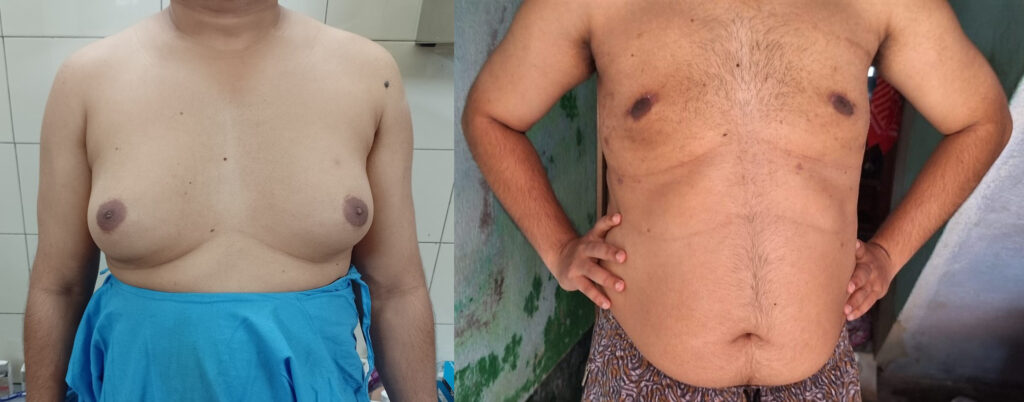
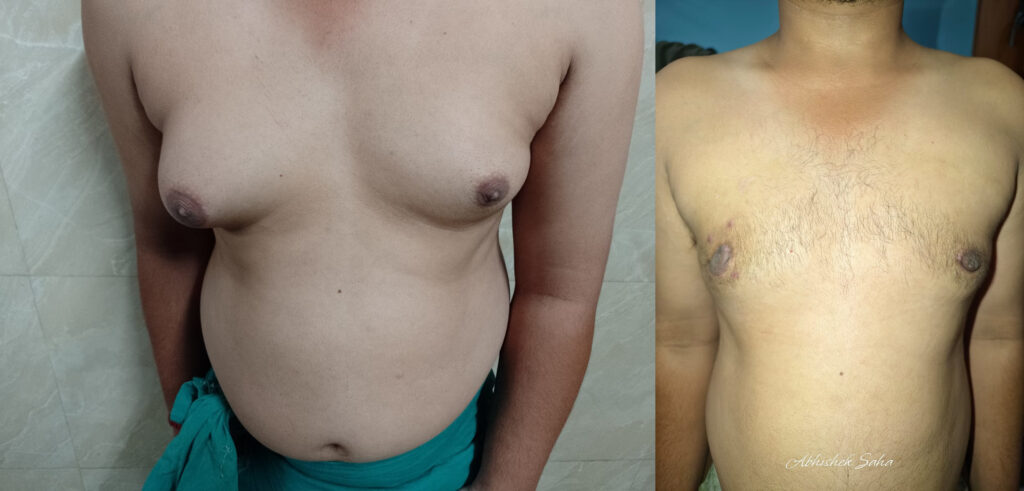
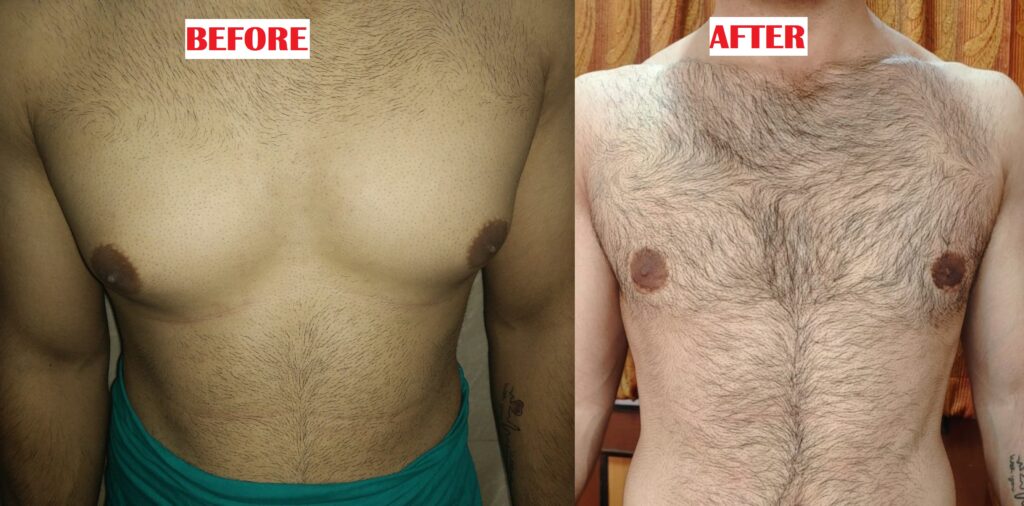
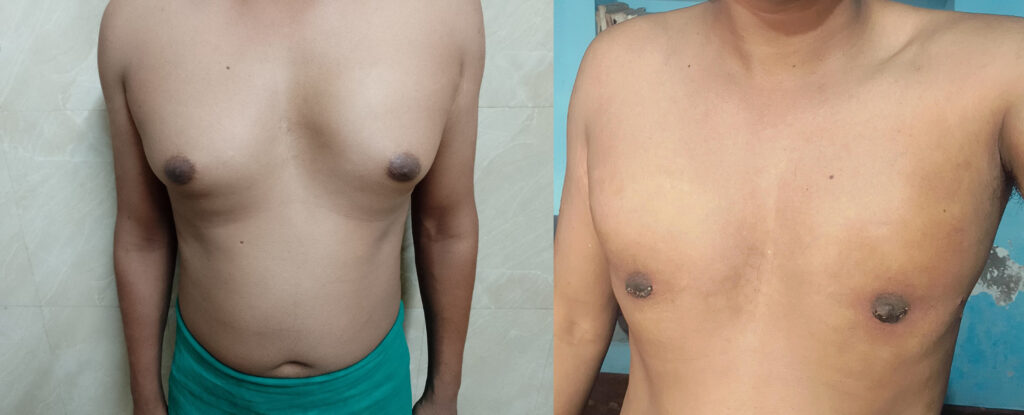
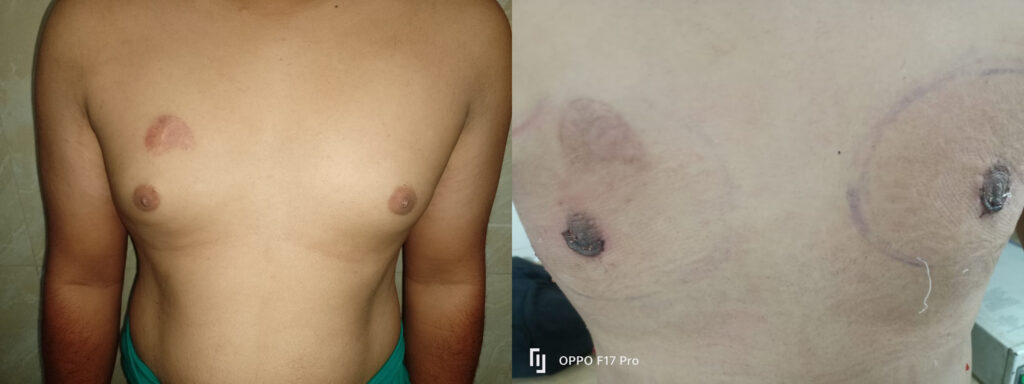
For more pictures and information click on the button below or visit the site:
https://gynecomastias.com/
Cost of Gynecomastia Surgery in Kolkata
The cost of gynecomastia surgery in Kolkata varies according to centers and can even reach up to Rs 1.5 lakh or more in corporate hospitals. Many affected patients are students and Prof. Adhikari understands that it might be difficult for them to arrange funds for their surgeries. Therefore, he tries to complete the entire process within Rs 30000 in needy patients. This is possible because of his ultimate experience with surgery under local anesthesia.
Moreover, discounts are offered to students and patients in need. For more information, visit
https://gynecomastias.com/services/
Frequently Asked Questions regarding Gynecomastia Surgery
Q: What is gynecomastia?
A: Gynecomastia is a condition in males where there is enlargement of male breasts in varying degrees.
Q: What is the incidence of gynecomastia in males?
A: Do not be depressed, this is an extremely common condition in males! Although the incidence varies among populations it is estimated that 3-6 boys out of 10 may harbor gynecomastia although all might not be large.
Q: When should gynecomastia be operated?
A: In patients having smaller degrees of gynecomastia, observation can be recommended till 18 years of age as many of these can resolve by themselves. Surgery after 18 years of age also has shown to have very little incidence of recurrence if done perfectly. However, in adolescents in whom there is advanced degree of gynecomastia, the surgery can be done in earlier years as it typically creates a social problem for individuals.
Q: What is the treatment for gynecomastia?
A: Only surgery can cure gynecomastia. Medicines have not been shown to have any effect on gynecomastia.
Q: What is pseudogynecomastia?
A: In obese individuals, with accumulation of body fat, fat also tends to accumulate in the chest. This condition is known as pseudogynecomastia where it resembles a gynecomastia but there is only fat, no glandular element.
Q: What are the components of male breasts?
A: Male breasts can comprise of a mixture of gland and fat like females although the proportions vary. In some patients, the swellings can be seen to be comprised exclusively of glandular tissue.
Q: My gynecomastia is hard, am I having breast cancer?
A: No! The consistency of gynecomastia varies. In some patients, the swellings can be soft while in others with exclusively glandular component, the swellings can be quite hard. This can be different from breast cancer.
Q: How do I distinguish breast cancer from gynecomastia?
A: Breast cancer in males is quite rare and usually affects one side. The growth can be quite rapid and the swelling is not uniform. If you have breast swellings it is best to check with a surgeon.
Q: Is there a risk of breast cancer if I leave my gynecomastia alone?
A: No. Surgery is done only for cosmetic reasons.
Q: If I go in for gynecomastia surgery will I have increased chances of breast cancer in future?
A: No. Surgery for gynecomastia does not increase chances of breast cancer.
Q: What are the components of gynecomastia surgery?
A: Liposuction can be done to address the fatty component in gynecomastia followed by open surgical removal of the underlying glandular component known as subcutaneous mastectomy.
Q: What is the type of anesthesia administered?
A: Unless the gynecomastia is very large, most of the cases can be performed under local anesthesia. In patients having advanced grades of gynecomastia general anesthesia may be required.
Q: Will it hurt if the surgery is done under local anesthesia?
A: You will feel the sting of injections but the surgical procedure is nearly painless.
Q: My skin over the chest is very loose. What can be done?
A: In many patients, the skin redundancy can be huge. In these cases, a different technique employing removal of skin is performed along with the above surgical procedures to address the same. Please note, a revision surgery may be required after 6 months to address any residual skin laxity.
Q: Will I be requiring any other surgical procedures in future?
A: Most cases do not require any further surgery. However, in a few cases, laxity of skin may need to be addressed 6 months after surgery.
Q: When will I expect to get final results?
A: 6 months after surgery although you will get an idea after 2-3 months only.
Q: Do I need any investigations prior to surgery?
A: Yes, blood tests are required prior to surgery if the surgery is done under local anesthesia. General anesthesia entails additional tests in the form of chest X-ray and ECG.
Q: Any other preoperative preparations I need to follow?
A: You may be asked to clean your chest on the day of surgery. If the surgery is being considered under local anesthesia then you may have a light meal on the day of surgery.
Q: What do I expect in the surgery?
A: Pictures would be taken first, followed by markings. Next follows anesthesia of the chest and then surgery.
Q: What are the postoperative instructions?
A: Immediately after surgery the area would be dressed and a pressure garment applied. You would be asked to take antibiotics and pain killers after surgery. You can start working from the next day (light job).
Q: Can there be bleeding after surgery?
A: Since drains are there in place you may expect soakage of dressings with blood stained fluid. This is normal and of no concern. If you have excessive bleeding (which is rare), contact your surgeon.
Q: When do drains come off?
A: 3-5 days or as determined by your surgeon.
Q: When are stitches removed?
A: 8-10 days or as determined by your surgeon.
Q: What happens if there is a collection of blood in my chest after surgery?
A: In very rare cases there can be accumulation of blood in your chest after surgery, In these cases, 1-2 stitches are removed in the nipple area and the blood evacuated and the cavity washed.
Q: I have a hard lump behind my nipples after gynecomastia surgery?
A: This is very common and does NOT imply that any glands were left behind. This usually happens because of clot formation. Just keep massaging on a daily basis and this will resolve by itself.
Q: How long do I need to wear the pressure garment? Do I need to wear it 24 hours?
A: Yes, in the initial postoperative phase you would need to wear the pressure garment 24 hours. The duration of pressure garment use varies between patients, your surgeon will guide you regarding this.
Q: When can I start exercises after surgery?
A: Usually 3-4 weeks after surgery.
Q: I am a smoker. Do I need to stop smoking?
A: Yes, smokers are advised to stop smoking 3 weeks prior to surgery and 3 weeks thereafter to reduce any risks associated with smoking. Same applies to alcohol consumption.
Q: Why are drains given?
A: After removal of the glands, there is a large cavity in the chest. Blood and fluids may collect in the cavity and may delay healing. Drains are put in so that any collected blood and fluids are promptly evacuated outside to aid in healing.
Q: Is gynecomastia surgery covered under medical insurance?
A: You would need to contact your insurance provider regarding this.
Q: How long do I have to stay after surgery?
A: If you are operated under local anesthesia then you will be discharged after surgery. General anesthesia usually entails a stay of 1 day.
Q: Where is the surgery performed?
A: The surgery can be performed in a nursing home (cheaper) or in a hospital (more expensive) setting as per your choice.
Q: Do I need anyone to accompany me at the time of surgery?
A: Yes, someone should accompany you at the time of surgery in case any emergency situation arises.
Q: Can I board a train or flight after the surgery?
A: Yes, you usually can if the surgery is done under local anesthesia, your surgeon would guide you regarding this.
Q: Are there any complications after surgery?
A: Your surgeon will provide you with a consent form which will highlight all possibilities. Usually, the surgery is extremely safe with minimal incidence of complications.
Q: Will I have a scar after surgery?
A: Yes, you will have scars over the areolar area and drain sites. The scars tend to lighten over months. In extremely rare cases hypertrophic scars and keloids may occur.
Q: I’m afraid of getting a depression in my chest after surgery?
A: A small amount of breast tissue is kept behind the nipple to prevent it from sinking. However, this will not grow back!
Q: My gynecomastia was operated but it seems it was not completely removed. Can a revision surgery be done now?
A: Yes, it can be done although a revision surgery may be difficult.
Q: Can I have a recurrence of gynecomastia?
A: No! If the glands are completely removed, then no recurrence is possible as glands can never grow back. However, if you continue to gain weight, then you may accumulate fat again the chest region which would be akin to pseudogynecomastia.
Q: Can you do a minimal incision technique in my case?
A: Depends! It is usually done in select cases with smaller swellings.

